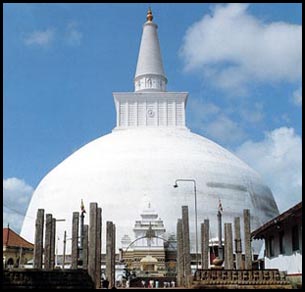The stupa is a mound or domed structure which serves as a Buddhist reliquary, or container for relics. Stupas are a form of Mandala, or sacred form of circle in Buddhist religious traditions. The Mandala is comprised of a square within the circle. This geometric pattern is thought to symbolically or metaphysically represent the Cosmos in microcosm.
Stupas were originally simple crude piles or heaps of mud which contained artifacts of Buddha. Several thousand stupas were built after the third century, with the advent and spread of Buddhism. They eventually evolved into engineered domed structures. This evolution of structure reflected the change in the stupa from an object of memorial to one of veneration.
Most of the stupas were built as corbelled arch domes, not as true arch domes (as I discussed in an earlier blog). These corbelled arch structures require a very large amount of masonry material, resulting in very strong structures which are robust, long lived and somewhat reminiscent of the Romanesque in their extensive use of material.
Some of the great stupas famous to us today are the Great Stupa at Sanchi, India; the Dhamek Stupa in northeastern India; the Ruwanwelisaya Chedi in Sri Lanka; and the Borobudur in Indonesia: the largest Buddhist structure in the world.
The existence of such a large number of ancient stupas today is testament to the fundamental strength and stability of this domed structure. Many of these stupas have survived a long history of seismic activity and major earthquakes. This domed structure also points to the cultural acceptance and reverence for the dome in Buddhist cultures, as seen in Muslim culture relative to the mosques.
The square within the stupa (as described by four sacred gates) is an interesting manifestation of “squaring the circle” as discussed earlier on this blog. This superposition of circle and square seems a fundamental archetype of human nature, and is found across many cultures and societies. As described in An Introduction to Stupas, “"The shape of the stupa represents the Buddha, crowned and sitting in meditation posture on a lion throne. His crown is the top of the spire; his head is the square at the spire's base; his body is the vase shape; his legs are the four steps of the lower terrace; and the base is his throne." This strong cultural acceptance and reverence indicates that a domed masonry structure is readily accepted and embraced by Buddhist societies.







https://bayanlarsitesi.com/
ReplyDeleteTokat
Kastamonu
Tekirdağ
Gümüşhane
7ZB4MB
kars
ReplyDeletesinop
sakarya
ankara
çorum
GPWR
ağrı
ReplyDeletevan
elazığ
adıyaman
bingöl
G43O
ankara evden eve nakliyat
ReplyDeletemalatya evden eve nakliyat
antep evden eve nakliyat
giresun evden eve nakliyat
kayseri evden eve nakliyat
XX8
0876D
ReplyDeleteUşak Evden Eve Nakliyat
Diyarbakır Evden Eve Nakliyat
Muğla Parça Eşya Taşıma
Iğdır Lojistik
Rize Evden Eve Nakliyat
93169
ReplyDeleteBolu Evden Eve Nakliyat
Tekirdağ Lojistik
Muğla Evden Eve Nakliyat
Ankara Evden Eve Nakliyat
Kayseri Parça Eşya Taşıma
B2E3E
ReplyDeleteÇerkezköy Motor Ustası
İzmir Şehirler Arası Nakliyat
Maraş Evden Eve Nakliyat
Yenimahalle Fayans Ustası
Elazığ Şehir İçi Nakliyat
Sivas Parça Eşya Taşıma
Artvin Şehirler Arası Nakliyat
Isparta Lojistik
Edirne Şehirler Arası Nakliyat
22B82
ReplyDeleteKonya Şehir İçi Nakliyat
Urfa Lojistik
Kars Şehirler Arası Nakliyat
Mersin Parça Eşya Taşıma
Elazığ Evden Eve Nakliyat
Kırklareli Şehir İçi Nakliyat
Isparta Evden Eve Nakliyat
Bolu Evden Eve Nakliyat
Urfa Evden Eve Nakliyat
E8A0B
ReplyDeleteEryaman Boya Ustası
NWC Coin Hangi Borsada
Aptos Coin Hangi Borsada
Aksaray Şehirler Arası Nakliyat
Bitlis Parça Eşya Taşıma
Trabzon Lojistik
Çanakkale Evden Eve Nakliyat
Nevşehir Şehir İçi Nakliyat
Batman Evden Eve Nakliyat
I want to share my testimony of how i become rich and famous today… i was deeply strangled up by poverty and i had no body to help me, and also i search for help from different corners but to no avail… i see people around me getting rich but to me i was so ashamed of my self so i met a man on my way he was very rich and he was a doctor so he told me something and i think over it though out the day so the next day i looked up and i keep repeating what he said to me. ” if you want to get rich quick and be famous” you need to cross your heart and do what is in your mind so i tried all i could in other for me to do as he said so later on i told my fellow friend about this same thing then my friend was interested in my suggestions so i decided to look in the internet and i found their number so we decided to contact them and unfortunately we did as they instruct us to do and later they told us to get some requirements and all the rest… so this initiation took us just a week and later on the great fraternity gave us $1,200,000 to start up our lives…. and now am testifying that if in any case you want to join any great fraternity all you need to do is for you to contact them because they are legitimate and they do as what they instructed them to do, so you can as well WhatsApp: +233594515977 or you can Email: Markroland08011@gmail.com
ReplyDelete